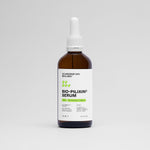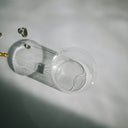Thinning hair can feel like a blow to your confidence, and hair fibres have stepped in as a quick fix for many. These tiny, microfiber particles promise to mask bald spots and create the look of fuller hair in seconds. But as their popularity grows, so do the questions: Are they safe? Could they actually harm your hair instead of helping it? One concern stands out above the rest—do hair fibres cause hair loss? If you’re already worried about shedding strands, the last thing you need is a product that might make it worse. In this article, we’ll tackle that question head-on, break down the facts with science, debunk myths, and give you everything you need to decide if hair fibres are right for you. Let’s get to the bottom of it!
Table of content
Do Hair Fibres Cause Hair Loss?
No, hair fibres do not cause hair loss. These products are made from natural materials like keratin, cotton, or rayon and are designed to cling to your existing hair for a cosmetic boost. They don’t penetrate the scalp, clog follicles, or interfere with hair growth. There’s no scientific evidence linking hair fibres to thinning or balding. That said, misuse—like leaving them on too long without washing—or rare allergic reactions could irritate your scalp, potentially affecting hair health indirectly. Used correctly, though, hair fibres are a safe, temporary way to enhance your look without risking your locks.
As your leading source for hair health information over the past 4 years, we never compromise on accuracy. When it comes to your health, you deserve information you can truly rely on - and earning your trust is our top priority.
Here's how Scandinavian Biolabs ensures every piece of content meets the highest standards of accuracy and integrity:
- Credentialed Experts: Our reviewers are actively practicing doctors and medical researchers
- Stringent Reviews: Content undergoes rigorous editing by subject specialists and review by a practicing doctor.
- Evidence-Based: We rely on well-established research from trusted scientific sources like peer-reviewed journals and health authorities.
- Full Transparency: Our editorial standards, writer credentials, reviewer credentials, correction process, and funding are all publicly documented.
- Independent Voice: While we do promote products, we operate in a vacuum to business operations. Our main goal is just an unwavering commitment to providing medically-sound guidance.
You can count on Scandinavian Biolabs to consistently deliver the trustworthy health information you deserve. Read our Editorial Standards.
What Exactly Are Hair Fibres?
Hair fibres are microscopic particles that mimic the texture and look of real hair. Most are made from keratin—the same protein your hair is built from—or other lightweight materials like cotton or rayon. They come in a range of colors to match your natural shade and work by sticking to your hair through static electricity. Sprinkle them on dry hair, pat them down or use a fixing spray, and voilà—thinner areas look fuller instantly.
Unlike treatments like minoxidil or supplements, hair fibres don’t claim to grow hair. They’re purely cosmetic, offering a visual fix for:
- Early-stage hair loss
- Naturally fine or sparse hair
- Temporary coverage for events or photos
Since they don’t interact with your scalp or follicles biologically, their impact is surface-level—literally.
Why the Hair Loss Worries?
Even though hair fibres are harmless on paper, some users hesitate. Let’s unpack the common fears and see if they hold up.
Myth 1: They Clog Hair Follicles
One worry is that hair fibres might block follicles, stopping hair from growing. The truth? These fibres are too big to seep into pores or follicles—they sit on top of your hair and scalp. Reputable brands design them to be non-comedogenic (won’t clog pores), and as long as you wash your hair regularly, there’s no buildup to fret over.
Myth 2: They Weigh Hair Down
Could the extra weight snap fragile strands? Not likely. Hair fibres are lighter than most styling products—think gels or heavy conditioners. They’re engineered to feel weightless, so breakage from fibres is far less common than from heat tools or rough brushing.
Myth 3: Allergic Reactions Cause Damage
Rarely, someone might react to an ingredient like a dye or preservative. Symptoms like itching or redness could lead to scratching, which might damage hair if severe. But this isn’t hair fibres causing loss—it’s an individual sensitivity. A quick patch test can dodge this bullet.
What’s the Science Say?
There aren’t stacks of studies on hair fibres and hair loss—probably because they’re a cosmetic product, not a drug or treatment. But experts weigh in. Dermatologists like Dr. Susan Stuart explain that hair fibres are “inert,” meaning they don’t mess with your scalp’s biology. Trichologists, who specialize in hair and scalp health, often recommend fibres to patients as a visual aid during treatments like hair transplants or regrowth therapies. If fibres were a hair loss culprit, professionals wouldn’t back them.
The takeaway? Science sees hair fibres as a neutral player—they neither grow nor harm your hair.
How to Use Hair Fibres Safely
While hair fibres won’t cause hair loss, a little know-how keeps them problem-free. Here’s how to use them right:
- Pick a Trusted Brand: Go for products with natural ingredients and no harsh chemicals. Cheap knockoffs might skimp on quality, risking irritation.
- Don’t Overdo It: A light sprinkle is enough—too much looks fake and could clump if not cleaned off.
- Wash Them Out: Shampoo regularly to avoid any buildup. Fibres rinse out easily, so daily cleansing keeps your scalp happy.
- Test First: New to fibres? Dab a bit on your scalp and wait 24 hours. No redness? You’re good to go.
Do Hair Fibres Help Hair Loss?
Not in the way you might hope. Hair fibres won’t stop or reverse hair loss—they’re a cover-up, not a cure. But they can work wonders for your self-esteem. By hiding thinning spots or widening part lines, they give you a fuller look fast. For many, that instant lift eases the stress of hair loss, which can feel like half the battle.
If you want to tackle hair loss itself, look beyond fibres. Options like minoxidil, finasteride, or even diet tweaks might address the root issue—chat with a dermatologist to find your fit.
Real Hair Loss Culprits to Check
Worried about shedding? Hair fibres aren’t the bad guy. Here’s what might be:
- Genetics: Pattern baldness (androgenetic alopecia) is the top cause, hitting men and women alike.
- Hormones: Shifts from pregnancy, menopause, or conditions like PCOS can thin hair.
- Diet Gaps: Skimp on iron, zinc, or biotin, and your follicles might weaken.
- Stress: Big life shakes can spark telogen effluvium, a temporary shedding phase.
- Health Issues: Thyroid problems, autoimmune conditions, or scalp infections could be at play.
If hair loss persists, a pro can pinpoint the cause—don’t just blame your styling tricks.
Wrapping Up: Hair Fibres and Your Hair
Let’s circle back: Do hair fibres cause hair loss? Nope. They’re a safe, cosmetic shortcut to thicker-looking hair, with no evidence of clogging follicles or triggering shedding. They’re not a fix for hair loss, but they’re a solid ally for boosting your look while you figure out the rest. Stick to quality products, use them wisely, and keep your scalp clean—you’ll be fine. If hair loss is eating at you, dig into the real causes with a specialist. For now, hair fibres can be your confidence sidekick, not your scalp’s enemy.
Got more hair fibre questions? Drop them below—I’m here to help!
Tired of Thinning Hair? Try a Clinically Tested Serum.
Looking for a natural way to regrow hair and achieve a thicker, fuller head of hair? Ditch the stinging nettle for hair loss – Bio-Pilixin Serum is a drug-free hair activation serum that delivers clinically tested results.
Here's why Bio-Pilixin is superior:
- Clinically Tested Results: 93% of users saw a reduction in hair loss, and 73% experienced increased hair density.
- Safe and Natural: Unlike harsh chemicals, Bio-Pilixin uses plant growth factors derived from stem cell technology to nourish hair follicles and stimulate growth.
- Fast-Acting: See visible results in as little as 45 days (most typically see results within 150 days).
Stop wasting time on unproven remedies. Bio-Pilixin is the safe, natural serum you've been searching for.
Read more:






